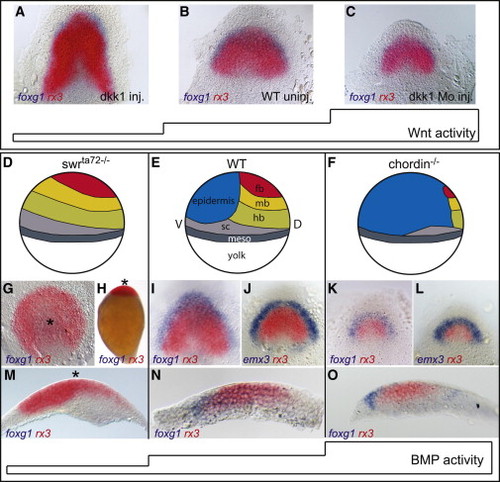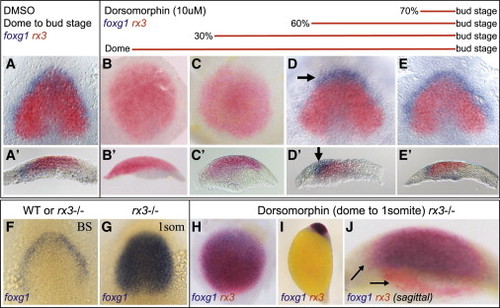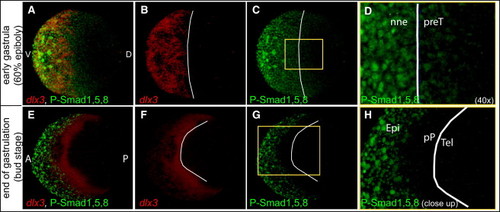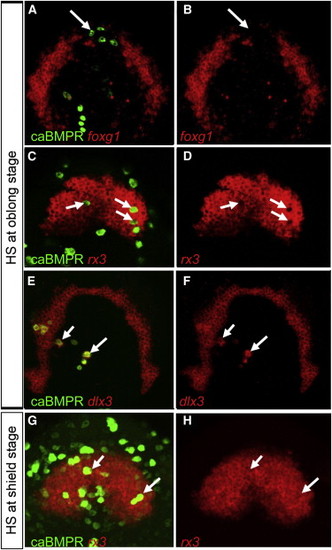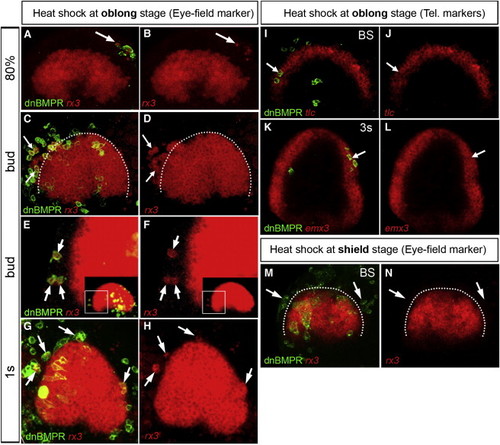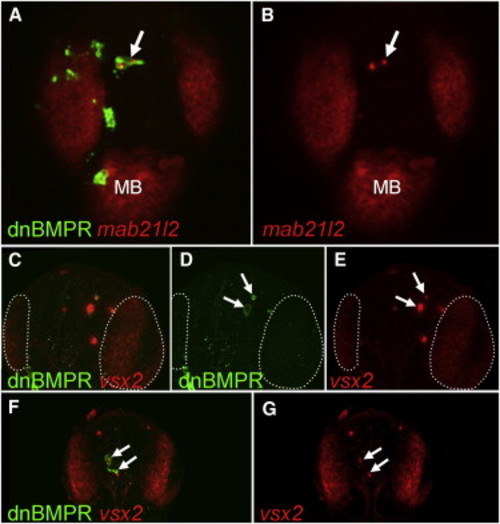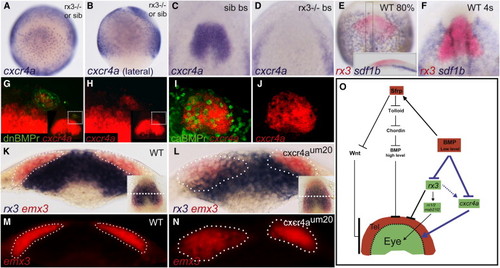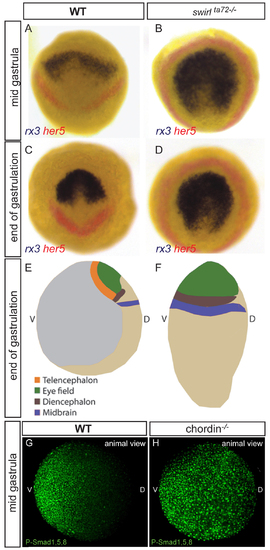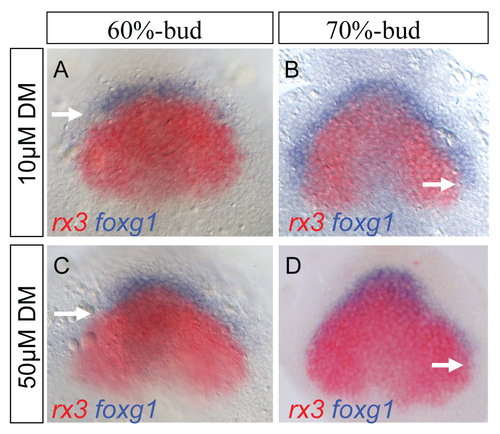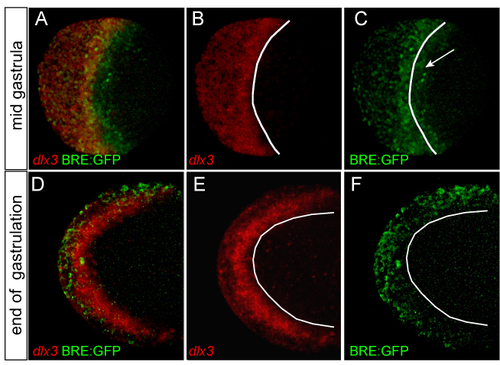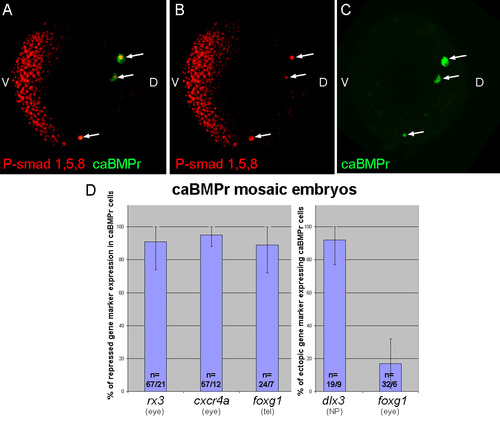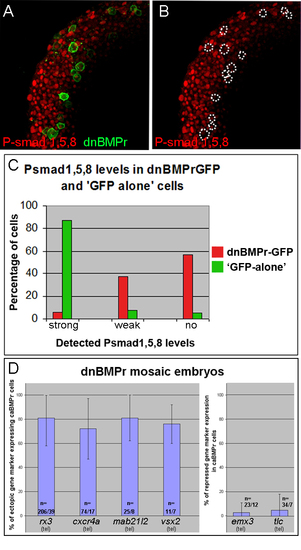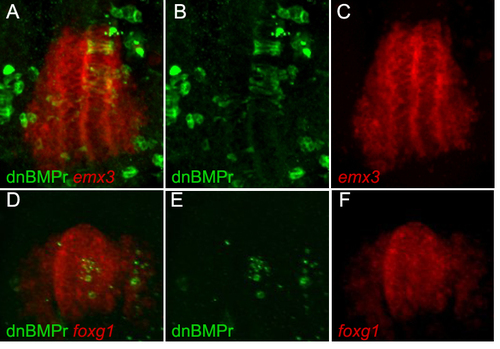- Title
-
BMP Signaling Protects Telencephalic Fate by Repressing Eye Identity and Its Cxcr4-Dependent Morphogenesis
- Authors
- Bielen, H., and Houart, C.
- Source
- Full text @ Dev. Cell
|
BMP, but Not Wnt, Subdivides the Anterior Forebrain Neural Fate into Eye and Telencephalon(A–C) Foxg1/rx3 in situ hybridization of dkk1 RNA (A) and dkk1 morpholino-injected embryos (C) compared to uninjected control (B) bud stage embryos (end of gastrulation), dorsal view, anterior to the top.(D–F) Schematic illustration of fate changes in response to BMP depletion in swrta72-/- (D) and elevated level of BMP signaling in chordin/ (F), compared to wild-type (E) bud stage embryos, lateral view, dorsal to the right. fb, forebrain; mb, midbrain; hb, hindbrain; sc, spinal chord; meso, mesoderm.(G–O) Foxg1, rx3 double in situ hybridization in swrta72-/- (G, H, and M), WT (I, J, and N), and chordin/ (K, L, and O). Asterisks in (G), (H), and (M) mark the center of the radialized axis. (G) Animal pole view, (H) lateral view, (I–L) dorsal view, anterior to the top, (M–O) sagittal section of the neural plate, anterior to the left. EXPRESSION / LABELING:
|
|
Patterning of the Anterior Neural Plate Requires BMP Signaling at Pre- and Early Gastrula Stages(A–E) Embryos were treated with 10µM of DM (B–E) or equivalent volume of DMSO (A) at time points indicated. All embryos were fixed at bud stage followed by double in situ against foxg1 and rx3. (A, D, and E) Dorsal view, (B and C) animal pole view, and (A2–E2) sagittal section. DM treatment from 60% epiboly until bud stage results in partial rescue of the telencephalon at most anterior position (arrows in D and D2).(F–J) In rx3/ mutants foxg1 expression is expanded across the eye field at one-somite stage (G), but not at bud stage (F). In DM-treated rx3/ embryos (H–J), the expanded eye field expresses foxg1 in the entire rx3-positive domain, except at its margin and a small stripe of cells at the medial/ventral position (arrows in J). (F and G) Dorsal view, anterior to the top, (H) animal pole view, (I) lateral view, (J) sagittal section, ventral to the left. BS, bud stage; 1som, one-somite stage. EXPRESSION / LABELING:
|
|
BMP Signaling Is Active at the Rostral Margin of the Neural Plate during Early Gastrulation(A–H) Whole-mount P-Smad1,5,8 antibody staining (green) and dlx3 transcript detection (red) in 60% epiboly (early gastrula, A–D) and bud stage (end gastrula, E–H). White lines mark the border of dlx3 expression. (A–D) Animal pole view, dorsal to the right. (E–H) Dorsal view, anterior to the left. (D) is a 40× magnification of the yellow boxed area in (C). (H) is a close-up of the yellow boxed area in (G). All figures are z-projections of confocal sections. nne, nonneural ectoderm; preT, prospective telencephalon; Epi, epidermis; PP, preplacodal territory; Tel, telencephalon. EXPRESSION / LABELING:
|
|
Repression of Anterior Neural Plate Markers by Elevated BMP Activity Is Limited to the Early Stage of GastrulationAll embryos were injected with HSP70:caBMPr plasmid at one- to two-cell stage followed by heat shock at oblong/early blastula stage (A–F) or shield/early gastrula stage (G and H) and fixed at bud stage. Heat shock induction of caBMPr at oblong stage represses foxg1 expression non-cell-autonomously (arrows in A and B) and rx3 expression cell autonomously (arrows in C and D). Dlx3 is ectopically induced in caBMPr-expressing cells inside the neural plate (arrows in E and F). Heat shock at shield stage does not affect rx3 expression (arrows in G and H). All figures are z-projections of confocal sections. |
|
Mosaic BMP Loss of Function at Early Stages inside the Telencephalon Results in Ectopic Expression of rx3 Embryos were injected with HSP70:dnBMPr plasmid at one- to two-cell stage followed by heat shock at oblong stage/early blastula (A–L) and shield stage/early gastrulation (M and N), respectively. The arrows in (A)–(H) mark cells with ectopic rx3 expression at stages indicated. (E and F) Close-up of the boxed area marked in the inset. (I–L) Expression of telencephalic (Tel.) markers, tlc and emx3, is maintained in dnBMPr-expressing cells (arrows in I–L). (M and N) Heat shock at 50% epiboly/early gastrulation does not result in ectopic rx3 expression (arrows in M and N). All views are dorsal, anterior at the top. White dotted lines in (C), (D), (M), and (N) mark the border of the eye field. All figures are z-projections of confocal sections. 1s, one-somite stage. |
|
Ectopic Expression of Retinal Markers in BMP-Depleted Telencephalic Cells at 24 hpf (A–G) Embryos were injected with HSP70:dnBMPr plasmid at one- to two-cell stage followed by heat shock at oblong/early blastula stage. The arrows indicate dnBMPr-positive cells in the telencephalon at 24 hr, which ectopically express retinal markers mab21l2 (A and B) and vsx2 (C–G). The number of transiently transgenic dnBMPr cells is significantly lower at 24 hpf than at earlier stages, and the remaining transgenic cells frequently undergo apoptosis (arrows in D). (C–E) White dotted lines mark the vsx2-positive retina. All views are dorsal, anterior at the top. All figures are z-projections of confocal sections. MB, midbrain. |
|
The Chemokine Receptor cxcr4a Demarcates the Border of the Eye Field and Telencephalon Downstream of BMP and Rx3(A–D) Cxcr4a expression in rx3/ or sib at 80% epiboly (A and B) and at bud stage in sib (C) and rx3/ (D) embryos. Sdf1b/rx3 double in situ at 80% epiboly/midgastrula stage (E) and four-somite stage (4s) (F). Inset in (E) shows a sagittal section of the boxed area, anterior to the left.(G–J) Cxcr4a transcript expression (red) in dnBMPr transgenic mosaics (green in G and H) and caBMPr transgenic mosaics (green in I and J) at bud stage. (G and H) Close-up of the boxed area marked in the inset. (I and J) Repression of cxcr4a expression in caBMPr-overexpressing cells.(K–N) Cross-section at medial A-P level of the eye field (dashed line in the insets in K and L). Segregation of rx3 (blue) and emx3 (red) expression domains in WT (K and M) and cxcr4aum20+/ x cxcr4aum20+/ crosses (L and N; n = 14/61) at four-somite stage. Dotted lines mark the border of emx3-expressing cells as defined by fluorescent images (M and N).(O) A model of the genetic network leading to formation of the eye and telencephalon. Blue arrows demonstrate the present work. Dotted-arrow line indicates that Rx3 is not essential for induction but for maintenance of cxcr4a expression. EXPRESSION / LABELING:
|
|
Double in situ of early eye-field (rx3) and midbrain (her5) markers in WT (A,C) and swr72-/- (B,D) embryos at 75% epiboly (A,B) and bud stage (C,D). Dorsal view (A,C) and animal view (B,D). (E,F) Schematic overview of changes of expression pattern in WT and swr72-/- at bud stage. The telencephalon at the margin of the neural plate is the only dorsal, neural region which is not expanded but absent in swr72-/-. Lateral view, dorsal to the right, anterior to the top. (G,H) Detection of P-smad1,5,8 in WT (G) and chordin-/- (H) embryos, animal pole view, shield to the right. Figures are z-projections of confocal sections. |
|
Increasing concentration of dorsomorphin does not alter the time window of BMP requirement for forebrain patterning. (A-D) Embryos were treated with 10µM and 50µM of Dorsomorphin, respectively at time points indicated, fixed at bud stage and stained for rx3/foxg1 expression. Arrows indicate partial foxg1 expression domain at the anterior margin (A,C) and complete rescue of the foxg1 expression domain (B,D). Dorsal views, anterior to the top. |
|
The zebrafish BMP Response Element GFP reporter line (BRE:GFP) indicates BMP activity at the border of the anterior neural plate at the early gastrula stage. (A-F) BRE-GFP embryos were fixed at 65% epiboly (A-C) and bud stage (D-F), respectively, stained for GFP (green) and dlx3 (red). White lines in (B,C,E,F) mark the border of dlx3 expression. The white arrow points to GFP positive cells at the margin of the anterior neural plate (C). (A-C) Animal view, shield to the right, (D-F) dorsal view, anterior to the left. All figures are zprojections of confocal sections. |
|
High levels of Psmad1,5,8 are induced cell autonomously in caBMPr transgenic cells causing robust changes of neural marker expression (A-C) Animal view of a mid gastrula caBMPr mosaic embryo stained for P-smad1,5,8 in red, shield to the right. Arrows point to single caBMPr-transgenic cells (green cells) in the dorsal half of the embryo which ectopically induce nuclear P-smad1,5,8 (red) in a cell autonomous manner. (D) Statistical analysis of repressed and induced gene expression in caBMPr cells, respectively. n=number of cells/ number of embryos. (tel, telencephalon; NP, neural plate). |
|
Majority of dnBMPr transgenic cells have no or low levels of P-Smad1,5,8 (A,B) Animal view of the ventral side of a mid gastrula dnBMPr mosaic embryo stained for Psmad1,5,8. (B) Dotted circles mark the location of dnBMPr expressing cells (green in A). (C) Distribution of P-smad1,5,8 signal intensities in dnBMPr (n=128 cells) and GFP-alone (n=148 cells) expressing cells. Statistical analysis of induced and repressed gene expression in dnBMPr cells, respectively. n=number of cells/ number of embryos. (tel, telencephalon) |
|
Telencephalic dnBMPr cells maintain expression of telencephalic markers at 24 hpf Emx3 (A-C) and foxg1 (D-F) in situ of dnBMPr mosaic embryos (HS at oblong/early blastula stage) at 24hpf. All views are dorsal, anterior to the top. |
Reprinted from Developmental Cell, 23(4), Bielen, H., and Houart, C., BMP Signaling Protects Telencephalic Fate by Repressing Eye Identity and Its Cxcr4-Dependent Morphogenesis, 812-822, Copyright (2012) with permission from Elsevier. Full text @ Dev. Cell

